Gutters
Unblocking a blocked gutter may not seem like an urgent task, but when left unattended, blocked gutters can wreak havoc on your home. Blockages cause water to overflow from the gutter which can damage timber fascia and soffit, stain brickwork, rot sarking felt and block rainwater pipes, eventually causing structural defects in your homes’ foundations. You can clean out your gutters by doing the following:
- You will need a ladder, a bucket of soapy water, a pair of gloves and a gardening trowel
- Dig out all of the debris from inside the gutter using your hands and the trowel
- Pay particular attention to any running outlets, being careful not to push debris into the downpipe
- If the downpipe is blocked, remove the pipe or rainwater shoe (at the foot of the pipe) and clear it out
- Once the gutter is clear, you can scrub the outside of the gutter using the cloth and water
- Finally, fit a Gutterbrush and Leaf Guard to prevent a future build-up of debris
View more information on preparing your gutters for winter here
Flooding
Around one in six homes in the UK are at risk of flooding from coastal, river or surface water. While it may not be possible to prevent a flood completely, you can do your best to prepare and flood proof your home:
- First, you can find out if your home is at risk of flooding here
- Next, you should sign up to flood warnings to give yourself plenty of notice if a flood is going to happen
- You can also get the flooding history for your property by emailing the Environmental Agency (this is free if it takes less than 18 hours to put together. Discuss timings with them first)
- Stock up on sandbags and flood boards if you live in an area at risk of flooding
- Replace wooden floorboards with concrete and replace carpet with tiles
- Fit a one way valve to your drainage pipes to prevent sewage from backing up into the home
- Install water resistant window frames and doors and replaster internal walls with water resistant material
- Invest in a soakaway or channel drain to help clear surface water

Icy Stairs & Patios
A big cause of injury during the winter months is from people slipping on ice, usually directly outside of their property. You should prepare your stairs and patios for the colder weather to avoid any incidents.
- Stay on top of any build-ups of hail or snow, sweeping it away before it freezes in place
- Sprinkle a layer of rock salt on the steps and patio to thaw ice and prevent more from forming (table salt will also work but rock salt is best)
- Do not use hot water to melt any ice as this will then freeze faster than cold water, increasing the problem
- Either cover up or bring garden furniture indoors to prevent rust or damage
- Invest in rough texture stair mats for safer grip

Roof Leak
If you suspect that your roof is leaking, the first step is to try and identify the cause of the leak, whether it’s a small hole, cracks around the chimney or something else. To identify the cause of the leak, follow this process:
- Wait for dry weather and ask a friend to help perform the leak test
- One person will take a hose up to the roof (if it is safe to do so) while the other person waits in the attic
- The person on the roof sprays the hose onto the roof, starting from the eaves and working upwards
- The person in the attic watches to see where the leak appears
- On a flat roof, the leaking water should appear at the source of the leak
- On a slanted roof, the leaking water will probably appear further away from the source of the leak as the water travels down the rafters
- Once the person in the attic has located the leak, they should push a nail through the hole in the roof so that it can be located and repaired from the top of the roof
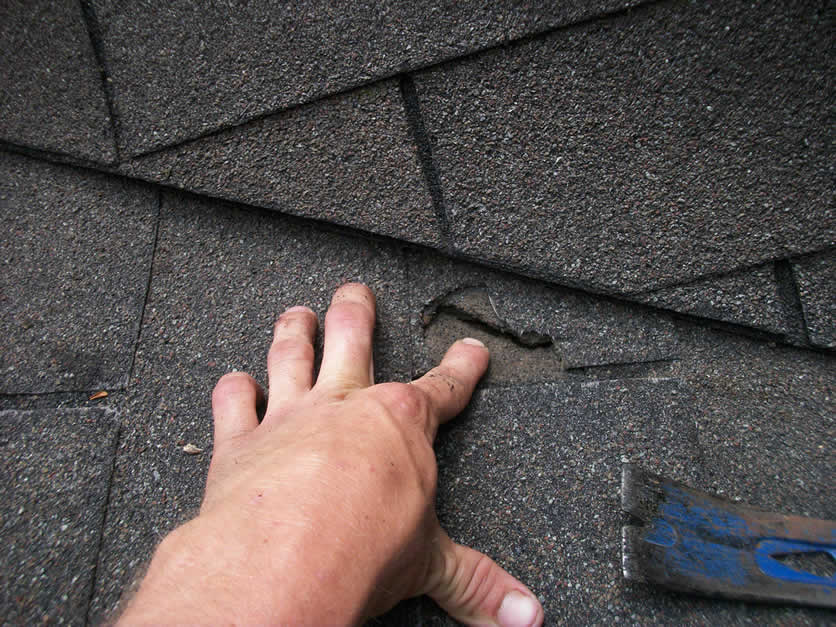
External PVC Cladding
External cladding provides an external barrier to your homes exterior which can really help to protect it during the winter. With a variety of designs, styles and colours available, it is a visually attractive way to improve your home. The main benefits to external PVC Cladding are:
- Provides a barrier against the winter weather, therefore protecting your homes exterior
- Helps to improve the insulation of your walls, therefore reducing thermal loss
- Has acoustic properties, helping it to reduce background noise
- Easy to work with and highly durable with an eye catching design
- Moisture cannot penetrate PVC cladding therefore it will not deteriorate or rot like timber cladding
Chimney Repairs & Maintenance
Maintaining your chimney is an essential task, especially if you plan on having open fires during the winter. You will need to clean your chimney before having an open fire as there might be a build-up of creosote within the flue or smoke chamber. Creosote is a highly flammable chemical which can form when damp wood is burned in the fireplace. We advise you call a chimney sweep to do the job properly. For any cracks or leaks coming from the chimney, follow these steps to make a quick and easy repair:
- Check the point where the chimney connects to the roof
- Locate any damaged caulking and remove it from the area using a putty knife
- Clean and fully dry the area
- Apply a new layer of caulking to the connection point along the same line which you already removed
- Work the caulking into the cracks using an applicator, then leave it to dry

Maintenance of Nearby Trees
Nearby trees can be a nuisance during the autumn and winter months as leaves and debris get blown off and end up in your gutters or drainage system. There is also a risk of larger branches falling and either injuring you or damaging your home. Our advice is to get on top of it and prune your trees to keep them manageable.
- Start by assessing the tree – how do you want it to look when you are finished?
- Identify the main structural branches and avoid removing them
- Identify damaged branches and remove them first as they pose the biggest threat
- Using a pair of secateurs, cut into the underside of the branch at the point where it connects to the tree or another branch
- Trim back longer branches which cause an obstruction or branches with a lot of foliage if you want to reduce potential debris
- Sweep up all debris surrounding the tree and dispose of them appropriately to ensure they don’t get blown into the drains or gutters

Window Seals
Gaps and cracks in the window frame can let cold air in and allow heat to seep out of your home during the winter. These cracks should be filled if you want to prevent the cold and possibly damp penetrating your home.
Filling external cracks
- Fill exterior gaps wider than 10mm with mortar
- Use a stiff brush to clean the crack or gap and the area around it
- Spray water into the gap to make it damp
- Press the mortar into the gap until it is filled then smooth it over with the face of the trowel
- Leave the mortar to dry
Filling internal cracks
- Fill interior gaps with caulking
- Clean the area of the gap or damaged caulking
- Use a caulking gun to apply a layer of caulking into the gap
- Smooth over using your finger and leave to dry
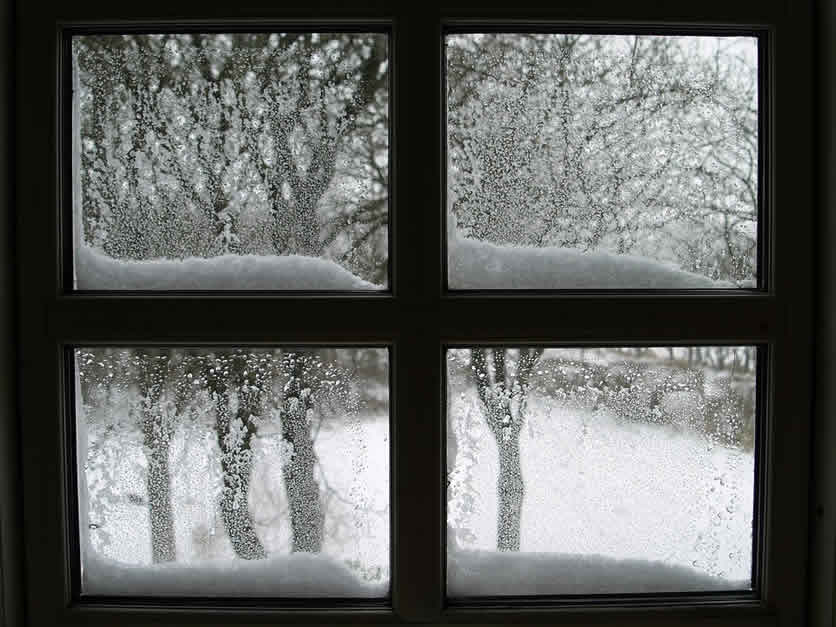
Door Seals
Draughts that come in through the gaps in your door frames can create quite a chill in your home as well as reducing the energy efficiency of your central heating. There are many items you can easily install yourself to ensure those cold winter draughts don’t penetrate your home, including brush draught excluders. Follow the instructions below to install a brush draught excluder:
- Measure the door and cut the brush draught excluder to fit the door, pinching the brush channel with pliers to prevent bristles from falling out
- Position your draught excluder on the bottom of the door ensuring it makes enough contact with the floor to prevent a draught
- Mark your fixing points on the door using a pencil (presuming your draught excluder comes with pre-cut fixing holes)
- Drill your holes into the door, then put the draught excluder in place and screw it on
- Make sure to test it out and check that the door still opens and closes appropriately
- For draughts coming from the top or sides of the door, attach draught stripping simply by sticking it around the edges of the door frame
Diverting Rainwater
During the wettest months, your downpipes can become a bit overwhelmed, but there is also a lot of perfectly good rainwater going to waste. A great solution to ease the pressure off of your downpipes and to collect the rainwater is to use a rain diverter and water butt.
The rain diverter allows for rainwater to be directed away from the downpipe and into a water butt. This water can then be used to water the garden during the summer, clean your car and a variety of other uses. Water butts come in a variety of shapes and sizes to accommodate the space in your garden and are an excellent eco-friendly way to save water and money on your water bills.
Moisture Damage/Damp/Mould
Moisture damage causes damp and mould problems in the home which can have a negative effect on your health, putting you at risk of respiratory problems, infections, allergies, asthma and a weakened immune system. There are a number of factors which cause damp and mould in the home, including the following:
- Condensation
- Leaks in your water pipes or waste pipes
- Rain penetrating gaps in your roof, windows, brick work or around doors
- Faulty guttering and pipes, flashings or ineffective pointing
- Rising damp caused by groundwater rising through the walls via capillary action
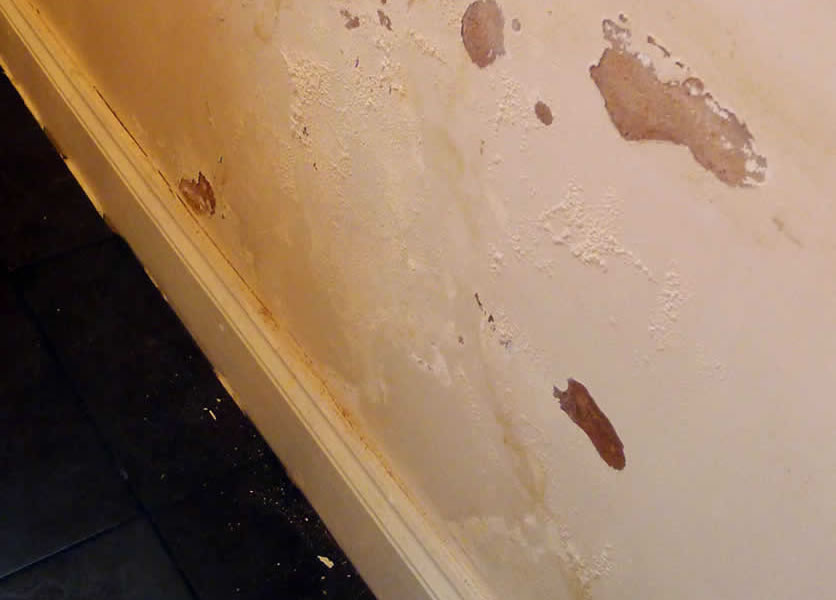
Freezing Pipes
During the winter, you might find that your pipes freeze up, stopping the flow of water. This can be particularly dangerous as it can lead to the pipes bursting, so it’s best to try and unfreeze the pipes as soon as possible. To avoid frozen pipes you should do the following:
- Insulate water pipes by wrapping lagging material around them
- Turn your central heating on frequently, even if just for an hour a day
- Regularly run your cold taps to keep the water flowing
- Keep doors and windows closed to ensure your home is as warm as possible
- Leave your cold tap dripping if you are out of the house all day, especially for taps which serve outdoor pipes
- Make sure your boiler is serviced and operating properly
For burst pipes outside of your properties boundaries, find your local water company here
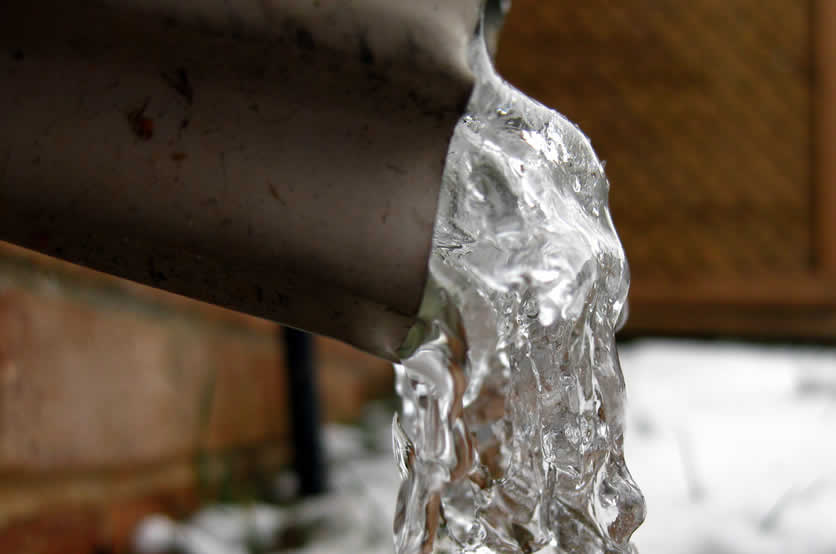
Blocked Drains
A blocked drains can cause flooding, horrible smells and all types of damage to your drainage system. There are many ways to clear a blocked drain, including the following for unblocking your sink or bath plug:
- Drain all water from the sink or bath
- Put half a cup of baking soda and half a cup of white vinegar down the drain (or you can use a chemical drain cleaner)
- Cover the plug with a hot cloth for half an hour while the mixture wears down the blockage
- Seal a plunger over the sink hole (this is easier if you add water to the sink/bath) and push up and down
- Hook out the remaining blockage using a metal coat hanger or drain snake
- Flush the drain out with boiling water, then continue flushing with larger volumes of water to clear the blockage
- Make sure you don’t put cooking oil or food down your sink to avoid future blockages
Blocked Toilet
If the water in your toilet bowl rises up and slowly empties when you flush the toilet, you have a blockage. It’s important to tackle the blockage early on to stop the blockage becoming worse. Here is the best method to unblock your toilet:
- You will need a set of drain rods to complete the job
- Start by flushing the toilet and then plunging it with the rubber plunger section attached to the drain rod
- Plunge until the water has drained from the toilet bowl, then flush again to test if it is still blocked
- If that didn’t work, you need to find a manhole outside the back or front of your home
- If you can find the soil stack, your manhole will probably be near that. Lift the manhole to access the drain
- Attach two or more of your drain rods with the plunger, tightening them with a wrench
- Feed the plunger rod into the drainage pipe, only turning them in a clockwise direction (otherwise they might come loose and get stuck in the drain)
- Attach more rods until your plunger is inserted well into the drainage pipe and then pull back and forth to plunger the blockage
- Your drain should then clear and you might have to clear out any waste leftover. Flush your toilet again to check it is clear
To avoid future blockages, do not flush nappies, sanitary towels, wet wipes and other non-dissolvable items.

Poor Insulation
A poorly insulated home is much less energy efficient and will put you at a real disadvantage when it comes to paying the bills. Many homes in the UK are entitled to free insulation under the Energy Companies Obligation (ECO) scheme. Cavity wall and loft insulation offer many benefits to your home, including the following:
- Annual financial savings of up to £175
- Annual CO2 savings of up to 720kg
- Reducing your reliance on central heating or cooling systems
- Loft insulation is quick and easy to install
- Cavity wall insulation can be more complicated but extremely effective when installed by a professional
- Reduced heat loss in the winter making your home much more comfortable

Central Heating
Your central heating will be essential during the winter, not only to keep you warm and comfortable but also to prevent pipes from freezing and mould from forming. Here are a few things you may want to do to ensure you get the best from your central heating this winter:
- Bleed your radiators
- Get your boiler serviced
- Invest in a modern, programmable thermostat to set the temperature by time
- Install insulation foil behind your radiator to reflect the heat into the room
- Invest in loft and wall insulation to help retain heat
- Look at switching energy providers to see if you could save money on your heating bills
Hygiene Cladding
During the winter, you are more likely to be cooking with the windows closed. This can lead to increased water absorption in the walls which in turn can create damp and mould. A simple solution to this problem would be to install hygiene cladding which is ideal for domestic kitchen use. They are many benefits to hygiene cladding, including the following:
- Excellent insulation properties, helping your home to retain heat in the winter
- High levels of chemical resistance and low water absorption
- Very strong and easy to wipe clean
- Fire resistant and self-extinguishing, reducing the risk of kitchen fires in your home
- Easy to install and looks attractive

Interior Mouldings
Whether you are a new home owner and want to put your own touch on your home without breaking the bank or are just looking to give your home a fresh new look, interior mouldings might be the ideal solution. There are a variety of options available which will add a decorative touch to your home:
- Interior Coving and Cornice
- PVC Dado Rails and Mouldings
- Plastic Skirting and Architrave
- Plastic Ceiling Roses
- PVC Columns
These robust and durable interior mouldings add the ideal decorative finish to your home with minimal effort and disruption. They can be used throughout the home and are not affected by moisture so can be used in bathrooms and kitchens too. We also offer a range of loft hatches and access panels.
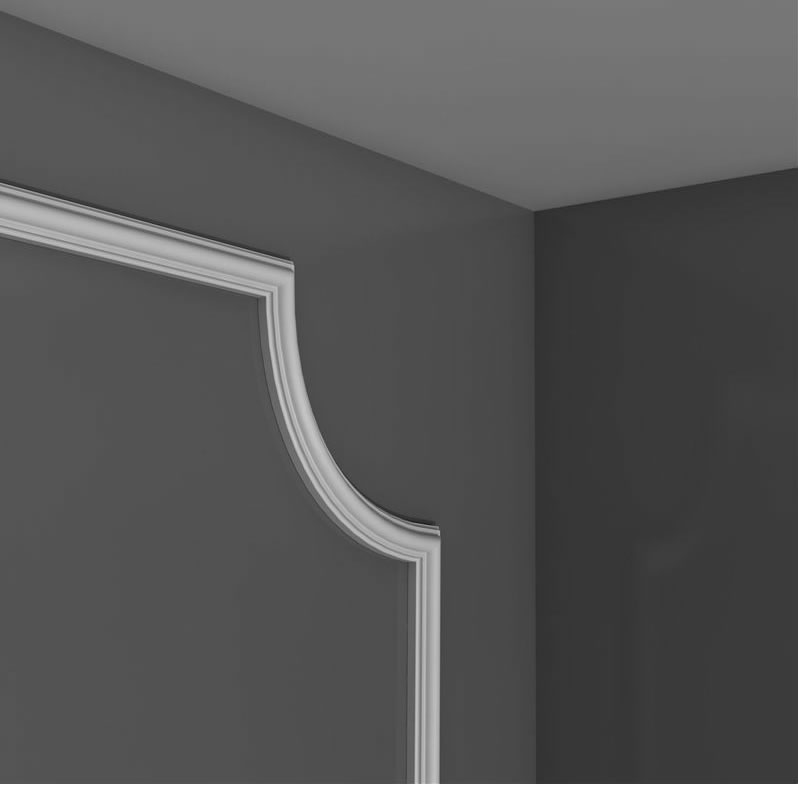
Inspection Chambers
Inspection chambers are an essential part of the underground drainage system as they allow access for testing, inspecting and clearing blockages. An inspection chamber comprises of a base, sectional risers with a seal and a manhole cover. They are particularly useful when a change in direction of the drainage system is required.
There are several different types of inspection chamber to choose from which are suitable for different scenarios. Drainage Sales provide 9 different types of inspection chamber to ensure you can get the right one for your home. An inspection chamber should be used in the following situations:
- Wherever a pipe joins the main drainage run (excluding rainwater pipes)
- Wherever a drainage pipe changes direction by 30° or more
- Wherever a drainage pipe has a straight run of over 22 meres
Soakaway Crates
Installing a soakaway system is the ideal solution to surface water build up. Heavy rainfall can cause water to build up around your home and in your garden, turning your lawn into a boggy mess and potentially causing sewers to burst, leaving a horrible mess around your home.
Soakaway crates are designed to collect rainwater underground and slowly infiltrate it back into the ground instead of discharging it into sewers. They are made from strong plastic and should be wrapped in a permeable membrane to aid the filtration process and prevent the soil around them from penetrating.
Ventilation
Nearby trees can be a nuisance during the autumn and winter months as leaves and debris get blown off and end up in your gutters or drainage system. There is also a risk of larger branches falling and either injuring you or damaging your home. Our advice is to get on top of it and prune your trees to keep them manageable.
Top tips
Start by assessing the tree – how do you want it to look when finished?
Identify the main structural branches and avoid removing them
Identify damaged branches and remove them first as they pose the biggest threat
Using a pair of secateurs, cut into the underside of the branch at the point where it connects to the tree or another branch
Trim back longer branches which cause an obstruction or branches with a lot of foliage if you want to reduce potential debris
Sweep up all debris surrounding the tree and dispose of them appropriately to ensure they don’t get blown into the drains or gutters



